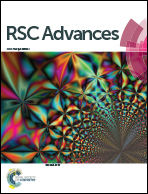Non-enzymatic electrochemical sensing platform based on metal complex immobilized carbon nanotubes for glucose determination†
Abstract
This work demonstrates the preparation of an electrochemical sensing platform (ESP) based on nickel salophen (abbreviated as NiII–S, where salophen is N,N′-bis(salicylidene)-1,2-phenylenediamine) immobilized multiwall carbon nanotubes (MWCNT) for electrochemical sensing of glucose in an alkaline medium. NiII–S is immobilized onto MWCNT by stirring MWCNT and NiII–S in DMF (MWCNT–NiII–S). The MWCNT–NiII–S is characterized by physicochemical and electrochemical techniques. Then, a glassy carbon (GC) electrode was modifies with the MWCNT–NiII–S composite (GC/MWCNT–NiII–S) and it exhibits efficient electrocatalytic activity towards glucose oxidation when compared to GC modified with NiII–S. Cyclic voltammetry and chronoamperometry techniques are performed to understand the reaction kinetics and to determine the kinetic parameters such as electron transfer coefficient, rate constant of electrode reaction and catalytic rate constant. At the GC/MWCNT–NiII–S ESP a linear calibration range for the glucose determination is observed from 500 nM to 20 mM with a limit of detection of 80 nM (S/N = 3) and sensitivity of 70 μA mM−1. Further, the present ESP is successfully utilized for the detection of glucose in a human blood serum sample with a good recovery (96.4–104.1%).



 Please wait while we load your content...
Please wait while we load your content...